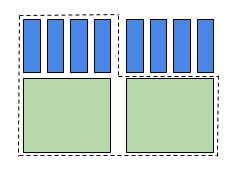Translations:Allocations and compute scheduling/20/en: Difference between revisions
(Importing a new version from external source) |
(Importing a new version from external source) |
||
| (2 intermediate revisions by the same user not shown) | |||
| Line 1: | Line 1: | ||
Research groups are charged for the maximum number of core equivalents they take from the resources. Assuming a core equivalent of 1 core and 4GB of memory: | Research groups are charged for the maximum number of core equivalents they take from the resources. Assuming a core equivalent of 1 core and 4GB of memory: | ||
* [[File:Two_core_equivalents.png|frame|Figure 2 - Two core equivalents.]] Research groups using more cores than memory (above the 1 core/4GB memory ratio) | * [[File:Two_core_equivalents.png|frame|Figure 2 - Two core equivalents.]] Research groups using more cores than memory (above the 1 core/4GB memory ratio) will be charged by cores. For example, a research group requesting two cores and 2GB per core for a total of 4 GB of memory. The request requires 2 core equivalents worth of cores but only one bundle for memory. This job request will be counted as 2 core equivalents when priority is calculated. See Figure 2. <br clear=all> | ||
Latest revision as of 15:31, 25 October 2024
Research groups are charged for the maximum number of core equivalents they take from the resources. Assuming a core equivalent of 1 core and 4GB of memory:
- Research groups using more cores than memory (above the 1 core/4GB memory ratio) will be charged by cores. For example, a research group requesting two cores and 2GB per core for a total of 4 GB of memory. The request requires 2 core equivalents worth of cores but only one bundle for memory. This job request will be counted as 2 core equivalents when priority is calculated. See Figure 2.
